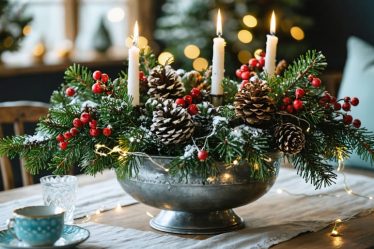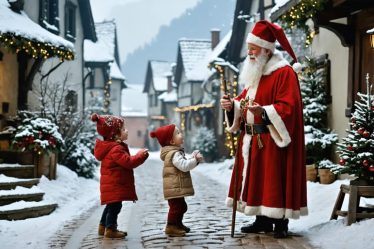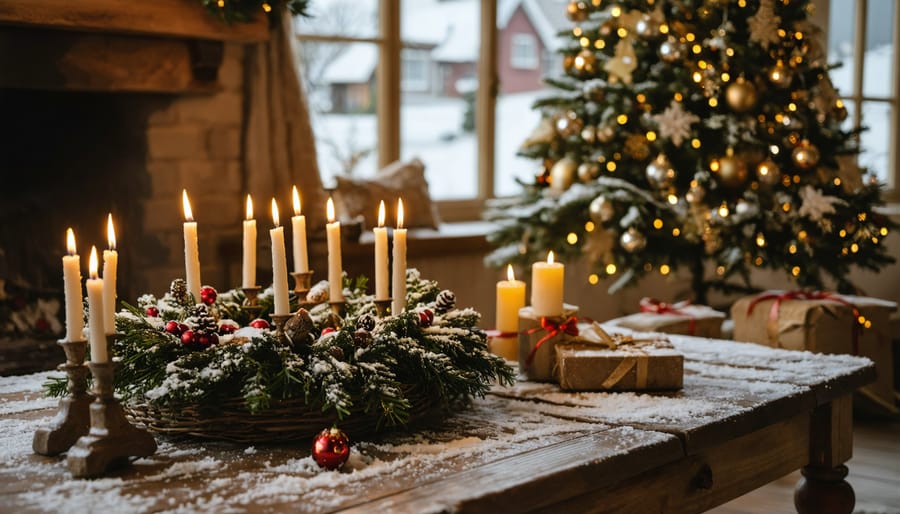
From the twinkling Christmas markets of Nuremberg to the cozy family gatherings around advent wreaths, German holiday traditions capture the essence of warmth, community, and celebration that many of us yearn for during the festive season. Picture yourself strolling through cobblestone streets filled with the irresistible aroma of freshly baked Lebkuchen and mulled wine, while handcrafted ornaments sparkle in shop windows. These centuries-old customs have not only shaped how millions of families celebrate worldwide but have also given us beloved traditions like the Christmas tree and advent calendars. Whether you’re planning to incorporate authentic German touches into your own holiday celebrations or simply curious about these rich cultural practices, discovering these traditions offers a magical way to deepen your connection to the holiday season. From St. Nicholas Day on December 6th to the grand festivities of Heiligabend (Christmas Eve), German holiday customs provide a perfect blend of meaningful rituals, delicious treats, and heartwarming gatherings that bring people together in celebration.
Advent Season: The Heart of German Christmas
The Advent Calendar Story
The beloved tradition of Advent calendars began in Germany during the 19th century, when families would mark each December day leading to Christmas with chalk marks or by lighting candles. The first printed Advent calendar appeared in 1908, created by Gerhard Lang, who was inspired by the little cardboard calendar his mother made him as a child, complete with 24 candies.
Today, these countdown calendars have evolved far beyond their simple origins. While traditional versions featuring religious imagery or winter scenes remain popular, modern interpretations include everything from beauty products to artisanal chocolates. German families often create their own DIY versions, a heartwarming activity that brings everyone together.
Making your own Advent calendar can be as simple or elaborate as you’d like. Try filling small cloth bags with treats and hanging them on a decorative branch, or transform plain envelopes into a wall display with number stickers and festive ribbons. Some families even turn it into a treasure hunt, hiding small gifts around the house with daily clues. Whatever style you choose, the magic lies in the daily anticipation that makes the Christmas season so special.
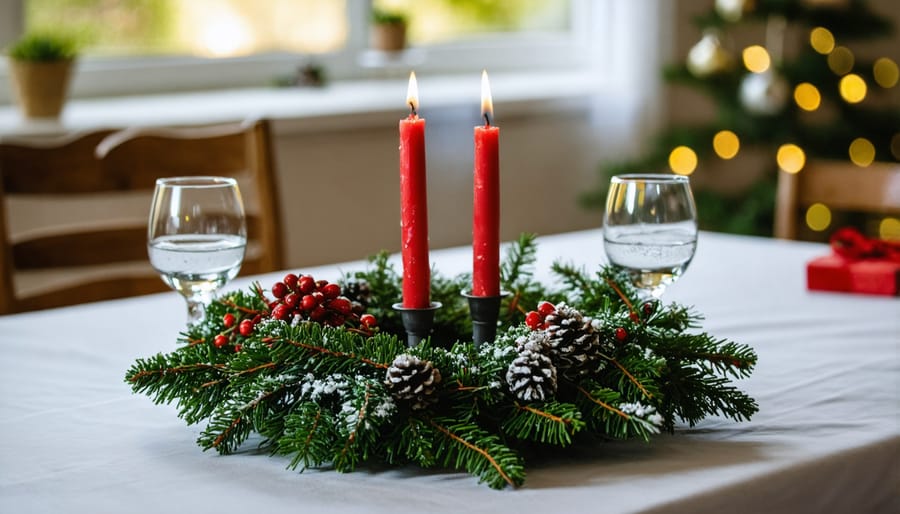
Sunday Rituals and Advent Wreaths
As December approaches, German families gather each Sunday for one of the most cherished holiday traditions – the lighting of the Advent wreath. These beautiful wreaths, crafted from fragrant evergreen branches and adorned with four candles, mark the countdown to Christmas. Each Sunday, families come together to light an additional candle, filling their homes with warmth and anticipation.
The ritual typically begins in the late afternoon when everyone gathers around the wreath for coffee and traditional Christmas cookies. The youngest child often gets the honor of lighting the candle, while older family members share stories and memories of past celebrations. As darkness falls, the soft candlelight creates a cozy atmosphere that Germans call “gemütlichkeit” – a feeling of warmth and contentment that’s particularly special during the holiday season.
Many families enhance this weekly tradition by singing carols, reading holiday stories, or crafting Christmas decorations together. The progressive illumination of the wreath serves as a visual reminder of the growing excitement as Christmas approaches, making these Sunday gatherings a magical part of the holiday season that both children and adults eagerly anticipate.
Festive German Kitchen Traditions
Christmas Cookie Chronicles
The heart of German Christmas tradition beats strongest in the kitchen, where generations gather to create treasured family recipes that fill homes with warmth and the irresistible aroma of butter, spices, and love. German Christmas cookies, known as Weihnachtsplätzchen, are more than just treats – they’re edible pieces of heritage that tell stories of countless December afternoons spent baking with Oma.
The classic Zimtsterne (cinnamon stars) sparkle with their signature white glaze, while buttery Vanillekipferl crescents practically melt in your mouth. My personal favorite is Lebkuchen, Germany’s answer to gingerbread, with its complex mix of warm spices and subtle orange notes. These cookies aren’t just made – they’re crafted with patience and precision, often using recipes passed down through generations.
The tradition typically begins on the first Sunday of Advent when families gather to bake their first batch. Children eagerly cut shapes with traditional cookie cutters, while more experienced bakers carefully pipe intricate designs on Spekulatius cookies. Many German families still maintain the custom of having at least seven different varieties of cookies displayed on their holiday cookie plate – a tradition that speaks to both abundance and variety.
Modern German homes might add contemporary twists to classic recipes, but the essence remains unchanged: creating memories while preserving delicious traditions that connect past and present.
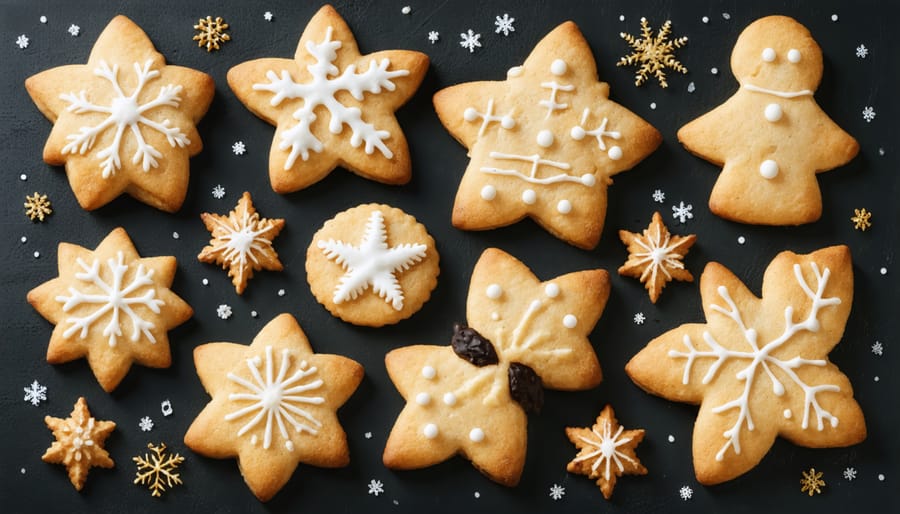
Holiday Feast Essentials
When it comes to German Christmas feasting, the aroma of roasted goose and sweet spices fills homes across the country. The traditional Christmas Eve dinner, known as Heiligabend, typically features simpler fare like potato salad and wurstchen (sausages), saving the grand feast for Christmas Day. Among the many traditional holiday dishes, the Christmas goose takes center stage, served with red cabbage, potato dumplings, and rich gravy.
The beauty of German holiday cooking lies in its heartwarming simplicity and deep-rooted traditions. I remember my first Christmas in Bavaria, where I learned that preparing the feast is as much about family togetherness as it is about the food itself. Plates of homemade cookies called Plätzchen, including favorites like zimtsterne (cinnamon stars) and vanillekipferl (vanilla crescents), appear throughout December.
No German Christmas table is complete without Stollen, a fruit-studded bread dusted with powdered sugar that symbolizes the baby Jesus wrapped in swaddling clothes. The preparation begins weeks in advance, allowing the flavors to mature perfectly. For drinks, warm Glühwein (mulled wine) and kinderpunsch (non-alcoholic punch) keep everyone cozy as they gather around the table to share not just a meal, but precious moments of connection and joy.
Markets, Music, and Magical Moments
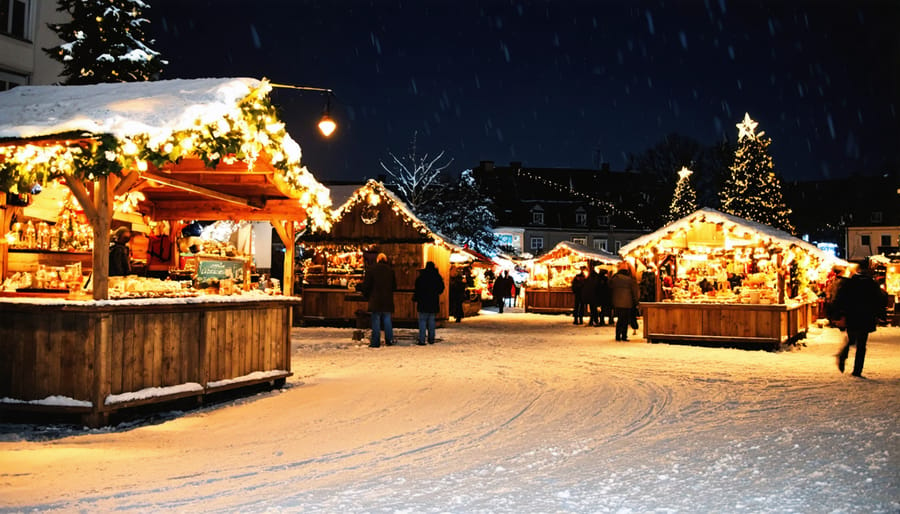
Christmas Market Must-Tries
No trip to a German Christmas market is complete without indulging in the magical array of treats and experiences that fill these festive wonderlands. The aroma of freshly roasted almonds (gebrannte Mandeln) wafting through the air is practically irresistible – these sugar-coated nuts are a market staple that will warm both your hands and heart.
You absolutely must try the beloved Lebkuchen, Germany’s answer to gingerbread, with its perfect blend of warm spices and honey. Each region has its own special recipe, making it fun to sample different varieties as you explore. For something truly warming, wrap your mittened hands around a mug of Glühwein, the traditional mulled wine that keeps market-goers cozy. Pro tip: many markets offer special collector’s mugs that make wonderful souvenirs!
Don’t miss out on the savory treats either. The sizzling Bratwurst served in a crusty roll is perfect for a quick dinner, while Kartoffelpuffer (potato pancakes) with applesauce make for a delicious snack. For dessert, seek out fresh Schneeballen (“snowballs”) – these round, sugar-dusted pastries are particularly popular in Rothenburg ob der Tauber.
Between bites, browse the artisan stalls for hand-carved wooden ornaments and delicate glass decorations that will bring German Christmas magic into your own home.
Songs and Celebrations
Music fills every corner of Germany during the holiday season, from cheerful carolers in town squares to families gathered around the piano at home. The beloved “Stille Nacht” (Silent Night) remains a Christmas Eve staple, often sung by candlelight in homes and churches across the country. Children particularly love “O Tannenbaum” and “Kling, Glöckchen,” which they learn in school and perform at holiday gatherings.
One of my favorite German holiday traditions is the spontaneous carol singing that happens in neighborhood pubs. Around mid-December, it’s common to hear whole rooms of people break into traditional songs, creating those magical moments that make the season so special.
The celebrations extend beyond music, with many towns hosting Christkindlmarkts where local choirs perform throughout December. These markets come alive with the sound of brass bands playing holiday favorites while visitors sip Glühwein and shop for handcrafted ornaments.
In homes, families often gather on December 6th for Sankt Nikolaus Day, singing special songs while children check their boots for treats. The tradition of singing continues through to Christmas Eve, when many families join together to sing carols before opening presents and enjoying their festive meal.
Creating Your Own German Christmas
Ready to bring a touch of German charm to your holiday celebrations? Creating your own German-inspired Christmas is easier than you might think, and it’s a wonderful way to add meaningful traditions to your family’s festivities. Start by setting up your tree on December 1st, following the German custom of extending the celebration throughout the month. Add authentic touches with traditional wooden ornaments and real beeswax candles (or LED alternatives for eco-friendly holiday celebrations).
Create a cozy atmosphere with a traditional Advent wreath centerpiece, lighting one candle each Sunday leading up to Christmas. Fill your home with the irresistible aroma of freshly baked Lebkuchen and Zimtsterne by trying your hand at these classic Christmas cookies. Don’t forget to set up a small wooden pyramid (Weihnachtspyramide) – these charming decorations are perfect for mantels or coffee tables.
Make December 6th special by celebrating St. Nicholas Day. Place shoes by the door the night before and fill them with small treats and oranges for children to discover in the morning. On Christmas Eve, consider adopting the German tradition of opening presents after a special family dinner, making the evening the main celebration rather than Christmas morning.
Add to the festive atmosphere by playing traditional German carols like “O Tannenbaum” and serving mulled wine (Glühwein) for the adults and warm apple cider for the children. Remember, the beauty of adopting traditions is making them your own while honoring their origins.
German holiday traditions beautifully blend the magic of centuries-old customs with the vibrancy of modern celebrations. Whether you’re crafting homemade Advent calendars, baking Stollen with your children, or gathering around a twinkling Christmas tree, these cherished practices create lasting memories that bridge generations. What makes these traditions particularly special is their ability to adapt while maintaining their core essence. Today’s families might order their Christmas markets treats online or share their Adventskranz moments on social media, yet the fundamental spirit of warmth, togetherness, and festive joy remains unchanged. As we embrace these time-honored customs in our own unique ways, we’re not just celebrating holidays – we’re keeping alive a rich cultural heritage that continues to bring magic and meaning to the holiday season, no matter where in the world we call home.

